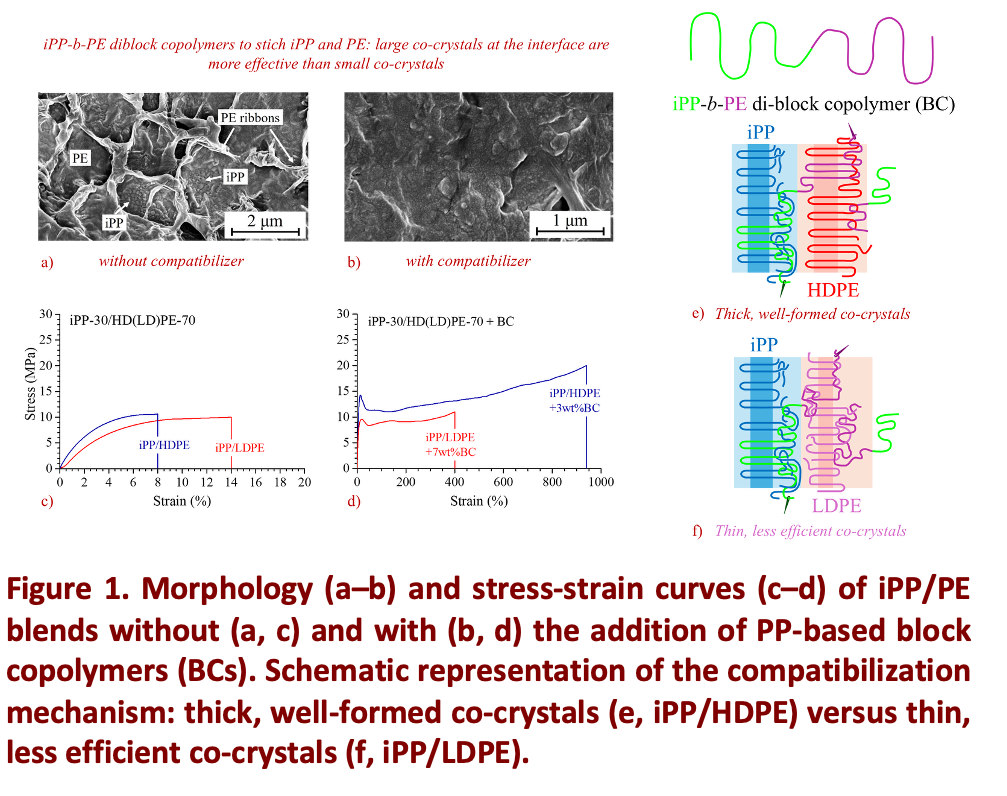Compatibilization of isotactic polypropylene (iPP) and polyethylene (PE) with PP-based block copolymers
Abstract

The compatibilization effect of two commercial PP-based block copolymers (BCs) on the morphology and mechanical properties of iPP/PE blends (30/70 wt%/wt%) was studied. It is well known that iPP and PE are hardly separable at the end of their life cycle, once rescued from landfills. However, due to their thermodynamic immiscibility, mixtures of iPP and PE exhibit poor mechanical properties compared to those of neat components. Consequently, in the absence of a compatibilizer, iPP/PE blends suffer from premature failure, low tensile deformation resistance, and reduced toughness (Fig. 1c)[1,2]. The aim of the study is to understand the role of molecular effects, such as the formation of entanglements at the iPP/PE interfaces, co-crystallization of the block chains with the crystalline lamellae of the host domains, and the size of the co-crystals formed at the interfaces. To achieve this, a smart design of experiments was set up, based on the selection of two different BCs as compatibilizers for two blend systems, specifically iPP/HDPE and iPP/LDPE blends, under different processing conditions (i.e., slow and rapid cooling from the melt). The selected BCs were a hard-hard copolymer (BC1), consisting of crystalline iPP and PE blocks, and a hard-soft copolymer (BC2), in which iPP crystalline blocks are linked to amorphous EP blocks. In both the BCs, the block weight ratio is 50/50. Addition of BC1 or BC2 has a remarkable effect on blend morphology, inducing a fine dispersion of the minority iPP phase in the PE matrix, even at low compatibilizer loads (3–5 wt%) (Fig. 1a-b). However, achieving finer dispersion translates into improved final properties of the blend only in the case of the crystalline-crystalline BC1 compatibilizer, which proves to be more effective for iPP/HDPE than for iPP/LDPE. In fact, in the first case, an amount as low as 3 wt% is sufficient to elicit good mechanical performance (Fig. 1d), while for iPP/LDPE blends the minimum amount of compatibilizer necessary to obtain ductile and tough material must be greater than 5 wt% (Fig. 1c). To account for these findings, we propose an adhesion mechanism based on the migration and localization of the compatibilizer at the phase-separated iPP/PE domain interfaces, with formation of molecular entanglements and co-crystallization of the copolymer chain segments with the chains of the host domains. For the iPP/HDPE blends, effective (trapped) entanglements are established along with well-formed co-crystals of large lamellar thickness (Fig. 1e) and only 3 wt% of BC1 is sufficient to ensure good ductility and toughness. In contrast, for iPP/LDPE blends, the lower thickness of the LDPE lamellar crystals results in less effective molecular connections (Fig. 1f), necessitating a larger amount of BC1 (over 5 wt%). Finally, as for the hard-soft BC2 compatibilizer, due to the amorphous nature of the EP block, no co-crystallization with the PE domains occurs, and good adhesion between the two components may be realized only in samples rapidly cooled from the melt, thanks to the “freezing” of a large content of trapped entanglements of BC2 at the interfaces of the host domains [3].

References
- J. Li, R.A. Shanks, R.H. Olley, G.R. Greenway Polymer 2001, 42, 7685.
- A. Graziano, S. Jaffer, M. Sain J. Appl. Polym. Sci. 2019, 136, 47838.
- O. Ruiz de Ballesteros, A. Rispo, G. Femina, S. Davide, F. Nocella, R. Romano, R. Cipullo F. Auriemma, Polymer 2025, 319, 128040.
Acknowledgments
All the authors acknowledge financial support under the National Recovery and Resilience Plan (NRRP), Mission 4, Component 2, Investment 1.1, Call for tender No. 1409 published on September 14, 2022 by the Italian Ministry of University and Research (MUR), funded by the European Union – NextGenerationEU– Project P20229ZRN7 ″ ECOPOLYCRYS" – CUP E53D23015900001 – Grant Assignment Decree No. 1384 adopted on September 1, 2023 by the MUR.

